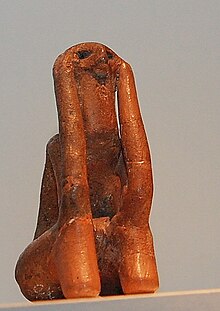Talk:Hamangia culture
| This article is rated Start-class on Wikipedia's content assessment scale. It is of interest to the following WikiProjects: | ||||||||||||||||||||||||||||||||||
| ||||||||||||||||||||||||||||||||||
[Untitled][edit]
I wonder if there's a connection between "Hamangia Thinker"

and Cycladic art -- AdrianTM 17:28, 24 April 2007 (UTC)
The picture inserted in the text does not represent "The Hamangia Sitting Woman". —Preceding unsigned comment added by 132.208.130.38 (talk) 22:57, 20 January 2009 (UTC) The picture in the text represent an image from Histria Museum, representing Hamagia artefacts.CristianChirita (talk)
there is a contradiction between the term neolithic and hunter-gatherers. —Preceding unsigned comment added by 79.110.115.86 (talk) 07:27, 29 June 2009 (UTC)
This business about the "Hamangia Thinker" is bizarre. There is another Neolithic clay figure that was found at a Cucuteni-Trypillian culture site in the town of Tarpesti, Romania called the "Thinker of Tarpesti" - and it is quite famous. And the resemblance between the Thinker of Tarpesti statue and the Hamangia Thinker statue image shown in this article is uncanny. Compare for yourself and see:
 |
 |
When I first saw the image of the Hamangia Thinker, I thought that it was a mistake, but upon closer examination, I realize that they are indeed two separate statues. Furthermore, both date back roughly to the same time. Interesting, no? ~ Saukkomies 02:18, 3 November 2009 (UTC)
- In particular those two "Thinkers" of Hamangia are completely untypical for the time, and only adapted to the sculpture of Auguste Rodin by some contemporal elements. In other words, they are to be very much suspected as modern counterfeit.HJJHolm (talk) 15:11, 11 March 2017 (UTC)
Boian culture dates[edit]
This says that the Hamangian culture was absorbed by the Boian culture by 4500 BC in its transition to the Gumelnit,a… but the page on the Boian culture says that it started around 4300 BC, the Gumelnit,a culture starting earlier around 4700 BC… I realise these terms and dates can be fuzzy, but that’s putting the end of the Boian centuries before the page on the Boian puts the beginning…?
I see Encyclopedia Britannica says the Boian culture started in 5000 BC. Though it seems the Boian and Gumelnit,a survived distinctly for a most of a thousand years?
Would greatly appreciate it if an actual expert could shed light on this, including any fuzziness of terminology and where the fuzzy boundaries lie. Harsimaja (talk) 22:50, 13 November 2021 (UTC)




